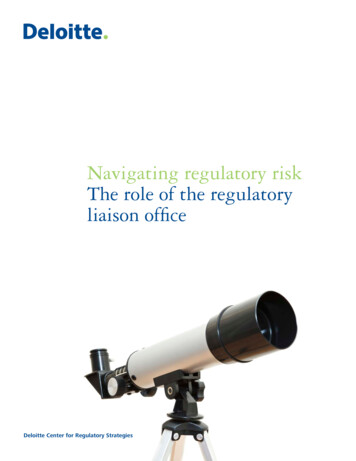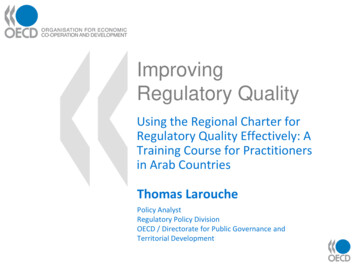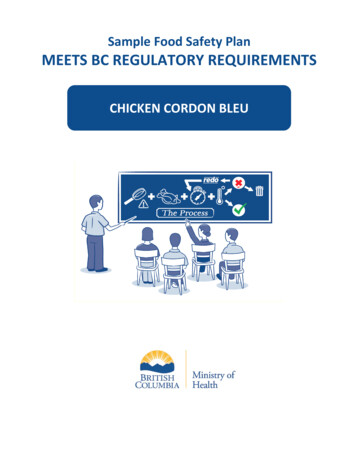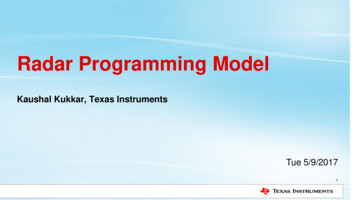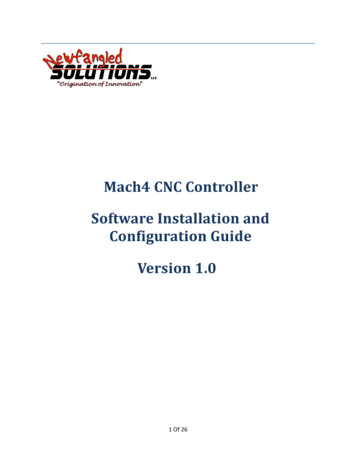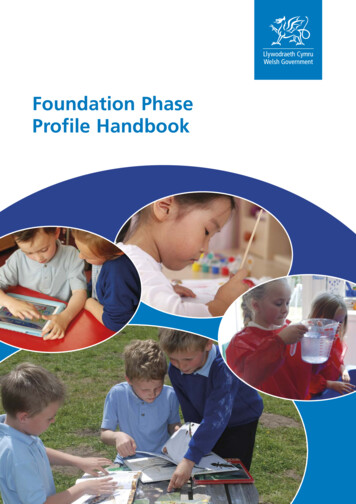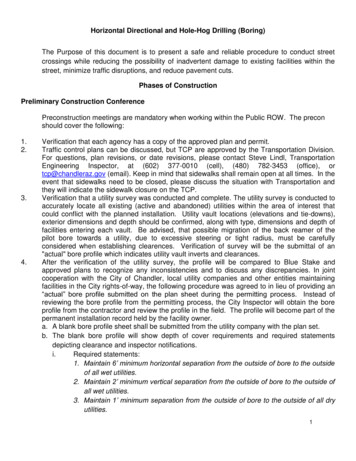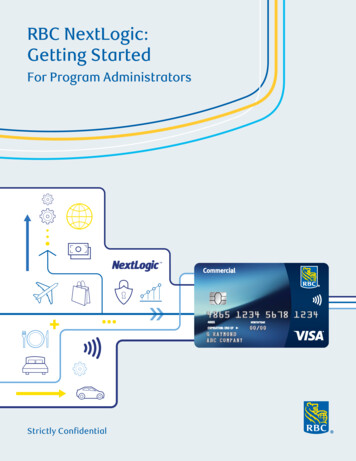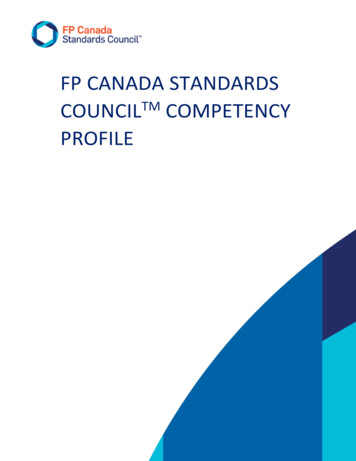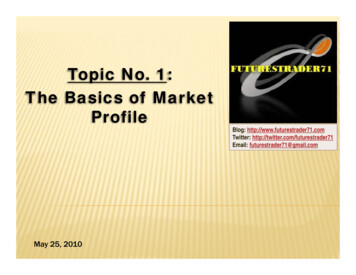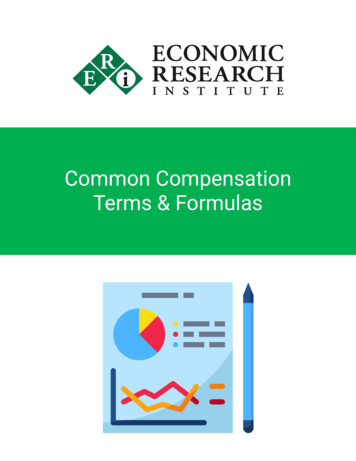
Transcription
Pharmaceuticals Export Promotion Council of India(Set up by Ministry of Commerce & Industry, Government of India)REGULATORY & MARKETPROFILE OF MYANMARDEMOGRAPHY
SL. CapitalYangon4Population55,622,506 (July 2018 est.)5Population growth rate (%)0.89% (2018 est.)6GDP (purchasing power parity) 329.8 billion (2017 est.)7GDP - real growth rate (%)6.8% (2017 est.)8GDP - per capita (PPP) 6,300 (2017 est.)9Epidemiology10Population below poverty lineDiabetes,Cancer,CVS diseases,HIV25.6% 2016 est11Age structure (%)0-14 years: 26.56%15-24 years: 17.51%25-54 years: 43.51%55-64 years: 7.75%65 years above:5.67%Source: CIA World Fact Book updated to July 2018Page 1 of 21
Introduction:Myanmar is a growing economy and is continuously supported by Government reforms. In the years tocome it’s manufacturing and construction sectors which would drive the economy. Its healthcareinfrastructure is gradually growing. Its Pharmaceutical market size was 456 million in 2017, and itis expected to touch 492 million by the end of 2018 with a growth of 7%. Percapita pharmaexpenditure was 8.5 in 2017Latest Updates In August 2018, the Myanmar Pharmaceutical Industrial Enterprise revealed that Myanmarimports pharmaceuticals and medical equipment worth USD400mn, with local production nowmeeting approximately10% domestic demand. In September 2018, the government called on countries in the Mekong basin to cooperate incombating the rising problem of antimicrobial resistance (AMR) through a regional healthsecurity project.Market OverviewCountry's pharmaceutical market is valued at USD 456 Million in 2017. This value is lower than that ofmost of the ASEAN countries, placing Myanmar below even Singapore in terms of absolutepharmaceutical market size, despite its much larger population (60mn versus 5mn). Looking ahead to2022 the market is forecasted to touch 656 million.There has been no proper audit of the market and the rough estimates put the market share of OTC to bethe highest and the prescription market is accessed only by the rich and top Government official of allthe departments.Myanmar's government has begun to introduce private health insurance programmes to the country thatbode well for the healthcare sector.Currently MNCs interest in this market is of lukewarm nature. It is hoped that passing of the newMyanmar Companies Act will open up previously closed sections of Myanmar's economy to foreigninvestment including the industrial equipment and pharmaceuticals sector. The new law might bode wellfor foreign direct investment inflows. Investment in the localized production of medicines bymultinational pharmaceutical companies is likely to increase.In June 2017, the Ministry of Commerce's Notification 36/2017announced that it had relaxed theprohibition on foreign trading, allowing 100% foreign-owned companies to distribute and retail certainlimited categories of products (including hospital equipment) to the domestic market and obtain importlicenses.Page 2 of 21
Rural markets of the country is dominated by the traditional medicines. India’s exporters are tobe encouraged to visit rural markets of the country especially of Ayush products.EpidemiologyCurrently both communicable & non communicable diseases more or less equally balanced. Diabetes,cancer, CVS diseases along with HIV are predominant.Novo nordisk of Denmark has invested over 1.2 million in Diabetes care program setting up a diabetesexcellence care unit, specialized program for diabetes care in Children and training of doctors andParamedic staff in diabetes care over a period of Four years.Pharmaceutical Trade:Country is very reliant on imported pharmaceutical products. This trend is expected to continue in thelong term, bringing opportunities particularly to overseas generic drugs producers.As of 2017, data from UN Comtrade notes that total imports amounted to USD349mn and is expectedto rise to USD511mn by 2022. This is a compound annual growth rate of 7.9%.India's is one of Myanmar's key trading partners. India (USD181.5mn) was the main import source ofpharmaceutical products in 2017, followed by Thailand (USD46.8mn), Indonesia (USD3 2.9mn),Singapore (USD5.2mn)and China (USD26.5mn). The country also exports pharmaceuticals to a fewcountries. In 2017its top export markets were Malaysia (USD66,331), Pakistan (USD25,200), and Japan(USD16,848).In September 2017, India and Myanmar formed a chamber of commerce (IMCC) in Yangon representedby large Indian corporations, small and medium enterprises, and entrepreneurs based in Myanmar toboost trade and forge closer economic ties between the countriesMyanmar is also gradually stepping up efforts to increase bilateral trade with its ASEAN partners. Inline with this outlook, Indonesia based conglomerate, Lippo Group, opened its first hospital in Myanmarin June 2015. According to its Chief Executive Officer James Riady, the company intends to maintainthe rapid expansion of facilities with the aim of having 20 hospitals in Myanmar within the next threeto five years. Additionally, bilateral trade between Myanmar and Vietnam hit USD538mn as ofDecember for the 2017-2018 fiscal year, already up 9% over the entire 2016-2017 fiscal year trade ofUSD494mn. In January 2018, Indonesia-based pharmaceutical company PTPhapros Tbkand MyanmarbasedMedi Myanmar Group established a joint venture to further develop the pharmaceutical andmedical devices industries in both countries.Local IndustryAs of 2018, local pharmaceutical production meets 10% of domestic demand, according to the MyanmarPharmaceutical Industrial Enterprise (MPIE).Page 3 of 21
Indian generic firms are the main foreign companies operating in Myanmar. Companies with branchesin the country include Ranbaxy, Wockhardt and Cipla. Majority of multinational pharmaceutical firmsdo not have operations in the country. It is hoped that the situation will improve as the country undergoeseconomic reform that will lead to a growing appreciation of better healthcare provision. Given the highlyrisky operating environment, poor quality of infrastructure in the country and fragmented nature of theindustry, foreign pharmaceutical firms are likely to leverage pharmaceutical distributors. Leadingdistributors are DKSH, SeaLion and Mega Lifesciences. According to local media, Myanmar Times, asof May 2015, six foreign direct investment proposals to build pharmaceutical manufacturing firms wereapproved but only two are in operation.They are - FAME pharmaceuticals and AA Medical Products.New Companies Act:The New Companies Act passed in late December 2017 will enable foreign companies to acquire a stakeof up to 35% in local companies (compared with none previously) and stipulates that businesses withforeign stakes of more than 35% will be considered foreign rather than domestic. Under the CompaniesAct of 1914, any company with even as little as a 1% foreign stake was classified a foreign company;however, under the new law, foreign-domestic partnerships will be considered local companies as longas the foreign share does not exceed 35%.This move could encourage foreign-domestic partnerships andjoint ventures, resulting in a greater transfer of skills and capital into the Myanmar economy. The AsianDevelopment Bank (ADB) hailed the act as 'an important foundation for the creating of the businessenvironment in Myanmar’.Statistics:A rough estimate shows that 12- 15% of India’s formulation exports are to Governmental organizationsand International NGO’s.India's Pharmaceutical exports to MYANMAR Million2015- 2016- 2017ContbnCategory161718GR%%Bulk Drugs and Drug Intermediates0.611.051.43 36.220.78Drug Formulations and Biologicals141.08 177.27 172.65 -2.6194.87Ayush0.560.700.66 -4.830.36Herbal Products0.280.430.50 15.490.27Surgicals0.921.331.62 21.660.89Vaccines10.515.585.13 -8.132.82Total153.96 186.36 181.98 -2.35100.00Contbnto Region0.4723.628.131.717.475.9615.41Page 4 of 21
ImportsRank12345678910Myanmar ' Top ten formulation Importing partners MillionCountry201520162017 796.23China23.2725.2227.509.055.23Rep. of t 2.44100.00Source:UN comtradeConclusions:Myanmar is considered as an LDC and is absolved from TRIPPS agreement till 2033. Two of the mostimportant diseases it is manifested with is diabetes and Cancer. It is said that more than 50% of the casesof diabetes are undetected in the country. Only 25% of the detected cases opt for Modern medicine forthe management of diabetes. Rest still go in for traditional medicines of Myanmar.Myanmar is the second largest exporting partner of India in Asean region next to Philippines. As agenerics exporting partner it is 12 th largest of India as a whole. Most of the exports of India is affectedby MSME companies.India’s exporters, planning investments in Myanmar may have an edge, if involved in the social causeof helping detection of Diabetes and educating the patients of the risk of diabetes management with thetraditional medicines which are not documented and benefits of managing diabetes with modernmedicine. Potential in diabetology and Cancer are immense.An entrepreneur looking at opportunities (manufacturing) in Myanmar would be better off planning abalanced product portfolio with some aiming at short term objectives like mild to moderate antibioticsAnti-hypertensives one or two Prazoles could also be planned. Therapy of diabetology starting withoral solids could be ideal and as India’s long acting insulins are now being exported advanced regulatedmarkets, these products could fetch good share in Myanmar.Page 5 of 21
REGISTRATION AND LICENSING REQUIREMENTS Regulatory Authority:The Food and Drug Administration(FDA) , Myanmar Website of regulatory Authority:http://www.fdamyanmar.gov.mm/ Fees for Drug Registration:USD 830 approximately1.Registration Assessment Fees300,000Kyats Fees for Laboratoryanalysis2. Registration Fees 500,000 Kyats Normal time taken for registration RegistrationFormat] Whether plant inspection is mandatory Validity of RegistrationRequirement:[Dossier ::06-12 MonthsACTDNo05 YrsFDA, Myanmar:The Food and Drug Administration (FDA) was established in 1995 as one of the divisions under theDepartment of Health. The FDA division was upgraded to a separate department in April, 2013.The aim of the department is to ensure the safety and quality of Food, Drugs, Medical Devices and Cosmetics in the country.Page 6 of 21
FDA Headquarter is located in Nay Pyi Taw, the capital city of Myanmar, with five major divisions: Administrative division,Drug Control division,Food Control division,Cosmetic and Medical Device Control division andLaboratory divisionAdministrative Committee: MFDBA (Myanmar Food & Drug Board of Authority) &CFDSC (Central Food and Drug Supervisory Committee)Technical Committee: DAC (Drug Advisory Committee)MFDBA, chaired by Minister for Health. The authority is vested power by the law to lay down policy,guidance on production, distribution, importation, exportation, quality assurance, standard setting,classifying controlled food, food additives and substandard foods, labelling and advertisement.FDSC (Food and Drug Supervisory Committees):The Food and Drug Supervisory Committees are formed as Central, State and Division, District andTownship Food and Drug Supervisory Committees respectively.Central FDSC (CFDSC), chaired by the Director General of Department of Health, licenses local drugmanufacturers and gives drug importation approval certificates to the importers.The State/Division FDSC, licenses drug wholesalers and retailers.At township level the FDSCs are managed by the Township Medical Officers. The committees consistof the Township Medical Officer, the Commander of the Police, and the representatives of the CityDevelopment Committee and the General Administration Committee.Drug Control DivisionCentral Registrations Inspection & licensing(Manufacturing & Import) PMSState & Regional Inspection(Manufacturing & Import) PMS (Pharmacy inspection,Drug sample Collection &Analysis, ADR Monitoring)Page 7 of 21
Asian Common Technical Documents (ACTD)The Common Technical Document is organized into four parts as follows:Part I. Table of Contents, Administrative Data and Product InformationPart II. Quality DocumentPart III. Nonclinical DocumentPart IV. Clinical DocumentPart I: Table of Content Administrative Information and Prescribing InformationPart I contains initially the overall Table of Contents of the whole ACTD to provide basically theinformation’s that could be looked through respectively. Secondly, the next content is theAdministrative Data where required specific documentation in details is put together such asapplication forms, label, package insert etc. The last section of this part is Product Information wherenecessary information includes prescribed information, mode of action, side effects etc.A general introduction to the pharmaceutical, including its pharmacologic class and mode of actionshould be included.Section A: IntroductionSection B: Overall ASEAN Common Technical Dossier Table of ContentsSection C: Documents required for registration (for example, application forms, labelling,Product Data Sheet, prescribing information)Part II. Quality DocumentPart II should provide the Overall Summary followed by the Study Reports. The quality controldocument should be described in details as much as possible.Section A: Table of ContentsSection B: Quality Overall SummarySection C: Body of DataPart III. Nonclinical DocumentPart III should provide the Nonclinical Overview, followed by the Nonclinical Written Summariesand the Nonclinical Tabulated Summaries. The document of this part is not required for GenericProducts, Minor Variation Products and some Major Variation Products. For ASEAN membercountries, the Study Reports of this part may not be required for NCE, Biotechnological Products andother Major Variation Products if the Original Products are already registered and approved formarket authorization in Reference Countries. Therefore, the authority who requires specific StudyReports should ask for the necessary documents.Section A: Table of ContentsSection B: Nonclinical OverviewSection C: Nonclinical Written and Tabulated Summaries1. Table of Contents2. Pharmacology3. PharmacokineticsPage 8 of 21
4. ToxicologySection D: Nonclinical Study Reports1. Table of Contents2. Pharmacology3. Pharmacokinetics4. ToxicologyPart IV. Clinical DocumentPart IV should provide the Clinical Overview and the Clinical Summary. The document of this part isnot required for Generic Products, Minor Variation Products and some Major Variation Products. ForASEAN member countries, the Study Reports of this part may not be required for NCE,Biotechnological Products and other Major Variation Products if the Original Products are alreadyregistered and approved for market authorization in Reference Countries. Therefore, the authority whorequires specific Study Reports should ask for the necessary documents.Section A: Table of ContentsSection B: Clinical OverviewSection C: Clinical Summary1. Summary of Biopharmaceutics and Associated Analytical Methods2. Summary of Clinical Pharmacology Studies3. Summary of Clinical Efficacy4. Summary of Clinical Safety5. Synopses of Individual StudiesSection D: Tabular Listing of All Clinical StudiesSection E: Clinical Study ReportsSection F: List of Key Literature ReferencesPage 9 of 21
Registration Procedure in Myanmar:Applicant: Authorized representative of product license holder at country of Origin Resident in Myanmar Local Company Representative- Company Employee technical competent personauthorized to serve as a contact personLOA- Letter of Authorisation: Manufacturer to Local Party Online submission of application in Form-I Verification by FDA and if acceptable, get a letter of intimation for remittance of Assessment ofFee Remit Registration Assessment Fee-300,000 Kyats Get DFDA Approval for Importation of Sample Drugs Submit Physical dossier (ACTD) Form-I within 60 days and samples accompanied with COA DFDA conducts Sample analysis and Document verification and submits report to DAC forapproval or rejection. In case of approved drug, DFDA issue letter of intimation to remit Registration fee Remit Registration fee-500,000 Kyats within 90 Days from Dt of intimation Issue of Registration Certificate by FDA.Guideline on Drug Registration Application, Date: 15-2-2018Government of the Republic of the Union of Myanmar, Ministry of Health and Sports Department ofFood and Drug Administration issued guidelines on Drug Registration Application Ref: FDA/(D)2018/149, Date :15-2-2018.Page 10 of 21
Initial application for Registration:1. An application for registration of drug must be submitted to the Department of Food and DrugAdministration in the original prescribed form (Form I Registration). As of 26 February 2018applications for new drug products and for renewals will have to be submitted using the onlinefacility at https://user.dcdfdamm.online. Applications that have not been submitted through theonline facility will no longer be accepted. In case of online applications, Form I will have to beprinted by applicants using the appropriate system facility.2.A separate registration application has to be submitted for pharmaceutical preparations of differentstrength, different dosage form or different pack size. Provisions have been made to avoidduplications in printing physical dossiers.3.Online submissions are first screened by FDA and, if found to be receivable, applicants will berequested to submit a physical dossier consisting of Form (I) accompanied by one set ofdocumentation. One additional copy of the dossier must be kept at company premises. Documentshave to be submitted in file in an order as listed in "Documents Required for Registration of Drugs".A list of documents submitted should be shown on the first sheet of the file. Physical dossiers mustbe submitted within 60 days of being notified by FDA that application is receivable. Failure to meetthe 60-day deadline will constitute forgoing of an application by an applicant. If so happens, neitherthe Registration Assessment Fees remitted nor any documents and drug samples will be returned.4.A dossier with incomplete documentation or documentation that does not bear the printed securitymakings cannot be received. Submission of non-receivable dossiers does not affect the 60-daydeadline. As a result, an application will be assumed to be forgone by the applicant if no receivabledossier is submitted within the 60-day deadline.5.(a) An application must be submitted in person by an authorised representative of product owner.Any application made by mail or any means other than in person, will not be accepted. Anauthorised representative has to be a resident of Myanmar.(b) Should an authorisation for representation be granted to a local company, the representativeshall be a company employee technical competent person authorised to act as a contact person.6.Registration assessment fees; 300000 Kyats must have been remitted to Department of Food &Drug Administration’s bank account MD-012456 at MEB before submission of the applicationform. The submission must be made within 183 days from the date of payment. A new paymentwill have to be made in order to submit an application after the payment validity deadline is passed.7.Applications containing active substances or fixed-dose combinations never marketed in Myanmarcan be received only if they have been already authorized for marketing in at least two the followingregulatory authorities: TGA, Australia: Health Canada; European Medicines Agency; MHRA,Page 11 of 21
United Kingdom; FDA, United States. Alternatively, they should have been prequalified by WHOor concern indications that are of specific relevance to Myanmar8.If it is an application for registration of drugs manufactured outside Myanmar, the Food and DrugAdministration will issue "Approval for importation of Drug Samples" after receiving anapplication for it. The drug samples as specified in the approval letter shall then be imported intothe country. The holder of the approval letter shall comply not only with the conditions stipulatedin the letter but also with the regulations of Trade and Customs Department.9.As per Ministry of Health Notification 3/93 dated 5-8-93 paragraph 5, prior approval shall beobtained from Food and Drug Administration for the importation of drug registration samples. TheFDA10. A) The following kinds of drug samples are normally required: Samples for laboratory analysis Samples for retention Samples for clinical trials, only for new products of Myanmar that need to undergo clinicaltrial.B) For the total numbers of sample drugs to be submitted, please refer to “Required quantities ofsamples for registration" (Annex III) of the guideline.C) All drug samples must be accompanied by the information described in annex VII of theguideline as well as their respective analytical report (certificate of analysis). The name anddesignation of an official who signs the report must be stated. A photocopy of the analyticalreport is not acceptable.11. The evaluation process for registration will be started only when all the requirements for registrationapplication have been met; viz.:(a) Remittance of Registration Assessment Fees,(b) Complete set of documents,(c) Sufficient quantity of good shelf-life (at least two thirds of shelf-life at lot release) drug samples.12.(a) When the drug is approved for registration, the applicant will be notified to remit 500,000Kyats as Registration Fee. The notification will be made only on the notice board of FDAor through the online system, where applicable.(b) Failure to remit Registration Fees within 90 days from the date of intimation will constituteforgoing of an application by an applicant. If so happens, neither the Registration AssessmentFees remitted nor registration documents and drug samples will be returned.13. Failure to make a follow-up of an application by an applicant for more than six months from thedate of remittance of assessment fees, will be taken as forgoing of an application.Page 12 of 21
14. The Drug Registration Certificate will be issued only after the acknowledgement of receipt ofpayments issued to FDA is submitted.15. The submitted dossiers and fees are not reclaimable in case of rejection or forgoing of application.Renewal of Registration1. Application for renewal of registration shall be submitted 90 days before the validity of theregistration terminates. Failure to adhere to the 90 days requirement may result in disruption ofcontinued validity of registration.2. Application shall be submitted in the same manner as prescribed for application for newregistration of a drug product.3. The drug samples for clinical trial are normally not required. The samples for laboratory analysisand for retention are still required. Please refer to "Required quantities of sample dr ug foranalysis and retention" (Annex III) of the guideline4. For renewal of validity of marketing authorizations issued after 31 December 2014, thedocumentary requirement is the same as that of an initial application (See Type of documentsrequired for registration Annex I). Information provided, however, has to be updated. Forrenewal of validity of marketing authorisations issued before 1 January 2015 the documentaryrequirement is provided in Annex V. New findings which had not been submitted in an initialapplication have to be submitted too, especially concerning drug safety profile.5. Registration Assessment fees must have been remitted to FDA at the time of application ofrenewal of registration. When the renewal of registration is approved of, 500,000 Kyats must beremitted as Registration Fees.6. Upon approval of renewal, a new Registration Number will be designated, which shall make theOld Registration Number null and void.7. Failure to apply for renewal of registration shall result in invalidation of registration with effectfrom the date of expiry of the certificate.Updating Changes to Registered Drugs (Variations)1. Updating changes to registered drugs shall be made only with the approval of Department ofFood and Drug Administration.2. For this purpose, the holder of Registration Certificate shall apply for variation of Registration toFDA, stating(a) Reason for change.(b) Relevant data or findings from studies on which is based the justification of change.(c) Significant effect of changes to the specifications of the drug product.Page 13 of 21
3. The following shall be submitted together with the application:(a) An attestation by the country's drug regulatory authority approving such changes. If theregulatory authority's attestation cannot be provided, explain the reason for it.(b) A photocopy of the Drug Registration Certificate.4. (a) When it is decided to approve the variation, 100,000 Kyats (per each variation) fee will belevied on an applicant. The Drug Advisory Committee may waive the fee requirement if itbelieves that the variation is of benefit to public as regards quality, safety and efficacy of drugs.(b) An original Registration Certificate must then be submitted to make approved amendmentson the certificate or print a new one.Fees Levied:1. Registration Assessment Fees 300,000Kyats Fees for Laboratory analysis2. Registration Fees 500,000 Kyats3. Variation of Registration 100,000 Kyats for each variationNote: (1) & (2) are levied either for new registration or renewal of registration.THE ASEAN COMMON TECHNICAL DOSSIER (ACTD) FOR THE REGISTRATIONOF PHARMACEUTICALS FOR HUMAN USEPART I: ADMINISTRATIVE DATA AND PRODUCT INFORMATION1. Application Form2. Letter of Authorisation3. Certification3.1 For contract manufacturing(a) License of pharmaceutical industries and contract manufacturer(b) Contract manufacturing agreement(c) GMP certificate of contract manufacturer3.2 For manufacturing "under- licence" (country specific)(a) License of pharmaceutical industries(b) GMP certificate of manufacturer(c) Copy of" under-license" agreement3.3 For imported products(a) Licence of pharmaceutical industries/importer/wholesaler (country specific)(b) Certificate of Pharmaceutical Product issued by the competent authority in the country oforigin according to the current WHO format.(c) Site master file of manufacturer (unless previously submitted within the last 2years)(country specific)4. Labelling4.1 Unit Carton4.2 Inner LabelPage 14 of 21
4.3 Blister/Strips5. Product Information5 .1 Package insert (package insert is required for generic products)5.2 Summary of Product Characteristic (Product Data Sheet) (required for NCE & Biotechnologyproducts)5.2. l Name of the Medicinal Product(a) Product Name(b), Strength(c) Pharmaceutical Dosage Form5.2.2 Quality and Quantitative Composition(a) Qualitative Declaration, the active substance should be declared by itsrecommended INN. Accompanied by its salt or hydrate form if relevant.(b) Quantitative Declaration The quantity of the active substance must be expressed per dosageunit5.2.3 Pharmaceutical Form Image clearly showing colour, markings, etc.5.2.4 Clinical Particulars(a) Therapeutic indications(b) Posology and method of administration(c) Contraindications(d) Special warning and precautions for use(e) Interaction with other medicinal products and other forms of interactions(f) Pregnancy and lactation(g) Effects on ability to drive and use machine(h) Undesirable effects(i) Management of overdose5.2.5 Pharmacological Properties.(a) Pharmacodynamic Properties(b) Pharmacokinetic Properties(c) Preclinical safety Data5.2.6 Phannaceutical Particulars(a) List of excipients(b) Incompatibilities(c) Shelf-life. Shelf-life of the medicinal product as packaged for sale. Shelf-life afterdilution or reconstitution according to directions. Shelf-life after first opening of thecontainer(d) Special precautions for storage(e) Nature and contents of container5.2.7 Marketing Authorization Holder5.2.8 Marketing Authorization Numbers5.2.9 Date of first authorization/ renewal of the authorization5.2.10 Date of revision of the text5.3 Patient Information Leaflet (PIL)Part II: QUALITYS Drug SubstancePage 15 of 21
S1 General InformationS1.1 Nomenclature- Information from the SIS1.2 Structure- Structural formula, including relative and absolute stereochemistry, the molecular formula, andthe relative molecular mass.S1.3 General Properties- Physico-chemical characteristics and other relevant properties including biological activity forbiotech.- Schematic amino acid sequence indicating glycosylation sites or the post-translationalmodifications and relative molecular mass, as appropriate.S2 ManufactureS2.1 Manufacturer (s)- Name and address of the manufacturer (s).S2.2 Description of Manufacturing Process and Process Controls.*S2.3 Control of Materials. *- Starting materials, solvents, reagents, catalysts and any other materials used in themanufacture of the drugs substance indicating where each material is used in theprocess, Tests and acceptance criteria of these materials.- Control of source and starting materials of biological origin.- Source, history and generation of the cell substrate- Cell banking system, characterization and testing.- Viral safety evaluation.S2.4 Controls of Critical Steps and Intermediates- Critical steps: Test and acceptance criteria, with justification including experimental data,performed at critical steps of the manufacturing process to ensure that the process iscontrolled. *- Intermediates: Specifications and analytical procedure, if any, for intermediates isolatedduring the proce
Myanmar is the second largest exporting partner of India in Asean region next to Philippines. As a generics exporting partner it is 12th largest of India as a whole. Most of the exports of India is affected by MSME companies. India's exporters, planning investments in Myanmar may have an edge, if involved in the social cause

